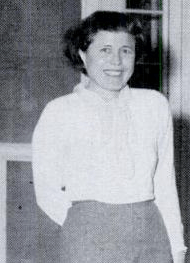Klara Dan von Neumann
| Klara Dan von Neumann | |
|---|---|
|
Klara Dan von Neumann. Photo by Alfred Eisenstaedt [1] | |
| Born |
August 18, 1911 Budapest, Austria-Hungary |
| Died |
November 10, 1963 (aged 52) San Diego, California, United States |
| Residence | United States |
| Nationality | Hungarian and American |
| Fields | Computer science |
| Institutions |
Princeton University Site Y, Los Alamos |
| Known for | MANIAC I |
Klára (Klari) Dán Von Neumann (18 August 1911 – 10 November 1963) was a scientist, and a pioneer computer programmer.
Life
Klara was born in Budapest, Hungary on August 18, 1911 to Károly - Karl Dán and Camila Stadler.[2][3] Her father had previously served in the Austro-Hungarian Army as an officer during World War I, and the family moved to Vienna to escape Bela Kun. Once the regime was overthrown, the family moved back. Her family was wealthy, and often held parties where Klara would meet many different people from various stations in life. At 14, Klara became a national champion in figure skating. She attended boarding school in England soon after.[3] Klara was married four times. After her second divorce, she married John von Neumann in 1938. Klara married Carl Eckart in 1958. She reportedly took her own life in 1963.[3]
Career
Klara was one of the world's first computer programmers and coders. She helped solve mathematical problems using computer code.[4] Klara wrote the code used on the MANIAC machine developed by John von Neumann and Julian Bigelow at the Los Alamos Scientific Laboratory.[5] She was also involved in the design of new controls for ENIAC and was one of its primary programmers.[6][7] She taught early weather scientists how to program.[8] Klára wrote the preface to John von Neumann's posthumously published, influential Silliman Lectures,[9] later edited and published by Yale University Press as "The Computer and the Brain".[10] She features significantly in computing historian George Dyson's book, Turing's Cathedral: The Origins of the Digital Universe.
Further Reading
- Dyson, G., Turing's Cathedral: The Origins of the Digital Universe, Vintage, 2012.
References
- ↑ Blair Jr, Cary (25 February 1957). Passing of a Great Mind. 42, No. 8. Time Inc. pp. 89–104. ISSN 0024-3019. Retrieved 31 March 2012.
- ↑ Chen, J with Su-I Lu, and Dan Vekhter. "Von Neumann and the Development of Game Theory". Retrieved 31 March 2012.
- 1 2 3 Dyson, George (2012). Turing's Cathedral: The Origins of the Digital Universe. Vintage.
- ↑ Devlin, Keith. "John von Neumann: The Father of the Modern Computer". Mathematical Association of America.
- ↑ Kelly, Kevin. "Q&A: Hacker Historian George Dyson Sits Down With Wired's Kevin Kelly". Wired. Wired.
- ↑ Coyle, Karen. "Turing's Cathedral, or Women Disappear". Coyle's InFormation. Karen Coyle. Retrieved 8 December 2013.
- ↑ Andrieu, Christophe; de Freitas, Nando; Doucet, Arnaud; Jordan, Michael I. (2003). "An Introduction to MCMC for Machine Learning" (PDF). Machine Learning. 50 (1/2): 5–43. doi:10.1023/A:1020281327116.
- ↑ Edwards, Paul N. (2010). A Vast Machine: Computer Models, Climate Data, and the Politics of Global Warming. The MIT Press. ISBN 978-0262013925.
- ↑ von Neumann, Klara. "Preface, Von Neumann Silliman lectures". The MacTutor History of Mathematics archive. School of Mathematics and Statistics, University of St Andrews Scotland. Retrieved 31 March 2012.
- ↑ Churchland, John von Neumann. With a foreword by Paul M. (2000). The computer and the brain (2nd ed.). New Haven, Conn. [u.a.]: Yale Nota Bene. ISBN 9780300084733.
